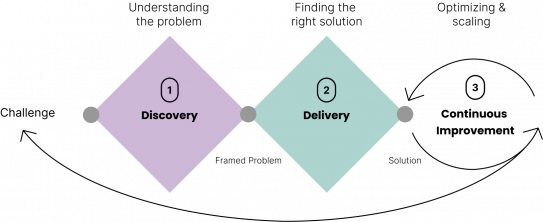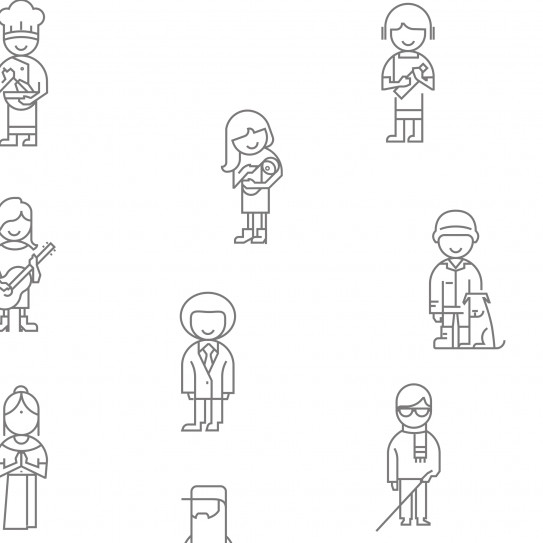
The 6 Steps to a Successful Discovery Process
For many companies, being successful means marketing digital products well: the ecommerce shop, platform, portal, or SaaS service. Keeping these relevant to your target audience requires a mindset focused on digital products and continuous improvement.
Embracing the Product Thinking mindset
Does your organisation still have silos? Then you're really not the only one, and that's not a problem at all. As long as you all embrace the mindset of product thinking. This mindset assumes that:
- The end user of the digital product is central to the organisation, despite silos.
- For that, the focus is on optimal customer experience and added value.
- Creating that added value requires collaboration and focus.
- You work based on data and insights.
- Where you experiment, you are also allowed to make mistakes, as long as you keep improving.
Projects are dead, Digital Products are key
Projects end, but digital products are never finished. This principle applies to all digital initiatives. Once you accept that as an organisation, you naturally start to see what is needed to improve digital services and stay ahead of the competition. To create and continue to develop digital products in this way, there are three pathways to go through as an organisation: discovery for finding those things for which you can deliver the most value to the customer, delivery for realising that value and continuous improvement for ongoing developments to add more value and become even more relevant as a company.

Discovery Process in six steps
In the discovery process, you dive deep into your organisation, customers, and market to find out where are the real challenges that stand in the way of success. The aim is to ultimately define a strategy with minimal uncertainties and maximum impact. This path has six parts with no fixed importance:
1. Alignment
A digital product soon touches three or more departments. What does success of the digital product mean for each department? More revenue? Or less manual work? Many organisations get wet on this because they are too big or have too many silos. What you are looking for here is a razor-sharp and broad-based definition of the maximum achievable outcome, within the given frameworks.
2. Research
Here you investigate customer needs and expectations, technological capabilities to serve the customer and your competition. It involves identifying the key questions you need to ask and actually answering them through various research methods. This is how you determine the possible directions and the desired speed of innovation.
3. Ideation
This is where you go from idea to concept. The aim is to take the first steps towards concrete solutions that solve a problem and create value. You can make this as big or small as you want: from new functionality, service, or environment to completely new infrastructure.
4. Creation
During creation, you will develop one or more ideas into a concept. You do this as lean-&-mean as possible so that in the next phase you can easily determine whether the concept is feasible and whether it also offers relevant value to the target group.
5. Validation
Next, you start testing internally and externally to verify whether the concept will work or whether you need to change things. Internally, you check how the digital product affects the business processes and whether there are any essential issues. Externally, you look at how your concept lands with your target group. Does it really offer added value?
6. Refinement
This is where you check everything: this is going to be the product, and this is how we are going to present it. Is the concept still not worth it? Then you repeat the discovery process until you are sure enough and you can start the delivery process until you are sure enough and you can start the delivery process
Three main lines consistently reoccur: the business, the customer, and the technology. Moreover, the six separate elements do not work in a linear fashion, because new insights can force you to switch gears: such as discovering that your competitor is doing exactly the same thing, realising that you can't get a logistical adjustment done, new stakeholders coming along with new insights, or not enough staff in a department.
In short, you never see the full picture beforehand. It only emerges when you get down to work. This is how you discover the real underlying problem that is standing in the way of success. As an organisation it’s crucial to be open to this, as it often happens that one gets stuck in an earlier idea and ends up solving the wrong problem.
From Discovery to Continuous Improvements
Many companies do not have the knowledge and expertise to go through a discovery process properly. That’s where agencies can play a role. The way discovery works often requires expertise. We ourselves decided not to offer head-and-tail projects anymore, but a method, a way of developing digital products. In the beginning, after all, nobody knows what the route to success looks like. We do know how you define it: involve all stakeholders, a multidisciplinary approach, management support, investigate problems, break down silos and keep improving step by step.
If you want to avoid a discovery track taking too long to get clarity and speed up, you can do dual tracking: a discovery and delivery track side by side. Problems are then found and solved in parallel. This is a prelude to the third track: continuous improvement.
Staying sharp together with Continuous Improvements
With continuous improvement, you stay relevant in the market and develop responsiveness. What exactly is happening? What impact does it have? How can we respond to it? Of course, you can do this internally if your company is big and/or experienced enough, but in my experience, this works best when an agency works closely with the client, and you form a close-knit team of people from both organisations. I firmly believe in this blended-team concept as a flywheel for success.
On the one hand, it helps when an independent party delivers the bad news or holds up a mirror to the organisation. Strange eyes compel, especially in a complex landscape with all kinds of stakeholders. On the other hand, an agency must keep proving itself and keep delivering results. There are limited resources within an organisation, while there will be more than enough features on the backlog. How do you prevent the person with the biggest mouth or the highest salary from pushing through their own wishes? Only with a shared focus on added value can you do a little better every day. Projects are dead. For success, you don't look at project needs, but at the weakest link within your organisation. You tackle those every time.
Did we pique your interest
Get in touch to discover how we can drive your digital sucess.
Contact Us


